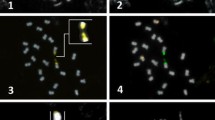Abstract
The current classification of genus Aotus includes nine species, four of which occur above the Amazon River and five below it. The position of several of these taxa as a valid species has been questioned. Recently, we described the chromosomal constitution of a population in the state of Rondonia, Brazil, whose karyotype typically presented a considerable accumulation of constitutive heterochromatin. To best characterize these heterochromatins, in this work we subjected the metaphases of these animals to banding using AluI, HaeIII, HinfI, RsaI, DdeI, MboI and MspI restriction enzymes and CMA3 and DAPI fluorochromes. The banded metaphases were also submitted to sequential C-banding. RsaI, DdeI and MboI enzymes showed, in all chromosomes, a banding pattern of C type, similar to that obtained using barium hydroxide. This banding was also seen with AluI, HinfI and MspI, but with reduction or elimination of the C-bands in the chromosome pairs 1, 3--7 and 9. MspI also reduced the C-band of pairs 11, 16--21 and 23. HaeIII induced intermediate bands between G and C. Considering the data of the different bands produced, it was possible to characterize at least three distinct types of constitutive heterochromatin in Aotus from Rondonia: (a) centromeric bands, (b) bands of the heterochromatic short arms and (c) interstitial bands.
Similar content being viewed by others
References
Bianchi NO, Bianchi MS, Wolff S, Cleaver JE (1985) The pattern of restriction enzyme-induced banding in the chromosomes of chimpanzee, gorilla and orangutan and its evolutionary significance. J Molec Evol 22: 323–333.
Boer de LEM (1974) Cytotaxonomy of the Platyrrhini (Primates). Genen Phaenen 17: 1–115.
Brumback RA (1973) Two distinctive types of owl monkeys (Aotus). J Med Primatol 2: 284–289.
Brumback RA (1974) A third species of the owl monkey (Aotus). J Hered 65: 321–323.
Donlon TA, Magenis RE (1983) Methyl green is a substitute for distamycin A in the formation of distamycin A/DAPI C bands. Human Genet 65: 144–146.
Giraldo A, Bueno ML, Silva E, Ramirez J, Umana J, Espinal C (1986) Estudio Citogenetico de 288 Aotus colombianos. Biomedica 6: 5–13.
Hershkovitz P (1983) Two new species of night monkeys, genus Aotus (Cebidae, Platyrrhini): a preliminary report on Aotus taxonomy. Am J Primatol 4: 209–243.
Koiffmann CP, Saldanha PH (1974) Cytogenetics of Brazilian monkeys. J Human Evol 3: 275–282.
Lima MMC (1986) Inter-relações das bandas C, DA/DAPI e NOR no genoma humano. Mastership Dissertation, Universidade Federal do Rio Grande do Sul, Porto Alegre, Brasil.
Ma NSF (1981) Chromosome evolution in the owl monkey, Aotus. Am J Phys Anthropol 54: 293–303.
Ma NSF, Elliot MW, Morgan L, Miller A, Jones TC (1976a) Translocation of the Y chromosome to an autosome in the Bolivian owl monkey, Aotus. Am J Phys Anthropol 45: 191–202.
Ma NSF, Jones TC, Miller A, Morgan LM, Adams E (1976b) Chromosome polymorphism and banding patterns in the owl monkey (Aotus). Lab Anim Sci 26: 1022–1036.
Ma NSF, Aquino R, Collins WE (1985) Two new karyotypes in the Peruvian owl monkey (Aotus trivirgatus). Am J Primatol 9: 333–341.
Miller DA, Choi Y, Miller OJ (1983) Chromosome localization of highly repetitive human DNA's and amplified ribosomal DNA with restriction enzymes. Science 219: 395–397.
Mittermeier RA, Coimbra-Filho AF (1981) Systematics: species and subspecies. In: Coimbra-Filho AF & Mittermeier RA, eds. Ecology and Behaviour of Neotropical Primates. 1st edn, Vol. 1. Rio de Janeiro: Academia Brasileira de Ciências, pp. 29–109.
Moorhead PS, Norwell PC, Mellman WJ, Battips DM, Hungerford DA (1960) Chromosome preparations of leukocytes cultured from human peripheral blood. Exp Cell Res 20: 613–615.
Mudry de Pargament MD, Colillas OJ, De Salum SB (1984) The Aotus from nothern Argentina. Primates 25: 530–537.
Pieczarka JC (1995) A natureza e a variabilidade da heterocromatina constitutiva em primatas sulamericanos. Doctoral Thesis, Universidade Federal do Rio Grande do Sul. Porto Alegre, Brasil.
Pieczarka JC, Nagamachi CY (1988) Cytogenetic studies of Aotus from eastern Amazonia: Y/autosome rearrangement. Am J Primatol 14: 255–263.
Pieczarka JC, Barros RMS, Nagamachi CY, Rodrigues R, Espinel A (1992) Aotus vociferans x Aotus nancymai: sympatry without chromosomal hybridition. Primates 33: 239–245.
Pieczarka JC, Barros RMS, Faria Jr FM, Nagamachi CY (1993) Aotus from the southeastern amazon region is geographically and chromosomically intermediate between A. azarae boliviensis and A. infulatus. Primates 34: 197–204.
Pieczarka JC, Nagamachi CY, Barros RMS, Mattevi MS (1996) Analysis of constitutive heterochromatin by in situ digestion with restriction enzymes in species of the group Callithrix argentata (Callitrichidae, Primates). Cytogenet Cell Genet 72: 325–330.
Scheres JMJC (1972) Identification of two Robertsonian translocations with a Giemsa banding technique. Humangenetik 15: 253–256.
Schweizer D (1980) Simultaneous fluorescent staining of R bands and specific heterochromatic regions (DA/DAPI bands) in human chromosomes. Cytogenet Cell Genet 27: 190–193.
Stuppia L, Romagno D, Palka G, Guanciali Franchi P, Parruti G, Calabrese G, Bianchi U (1991) AluI and HaeIII restriction enzyme banding patterns of Macaca fuscatta and Cercopithecus aethiops sabaeus chromosomes. Cytogenet Cell Genet 56: 59–60.
Sumner AT (1972) A simple technique for demonstrating centromeric heterochromatin. Exp Cell Res 75: 304–306.
Wright PC (1981) The night monkeys, genus Aotus. In: Coimbra-Filho AF & Mittermeier RA, eds. Ecology and Behaviour of neotropical Primates. 1st edn, Vol. 1. Rio de Janeiro: Academia Brasileira de Ciências.
Author information
Authors and Affiliations
Rights and permissions
About this article
Cite this article
Pieczarka, J.C., Nagamachi, C.Y., Muniz, J.A.P.C. et al. Analysis of constitutive heterochromatin of Aotus (Cebidae, Primates) by restriction enzyme and fluorochrome bands. Chromosome Res 6, 77–83 (1998). https://doi.org/10.1023/A:1009278727328
Issue Date:
DOI: https://doi.org/10.1023/A:1009278727328




